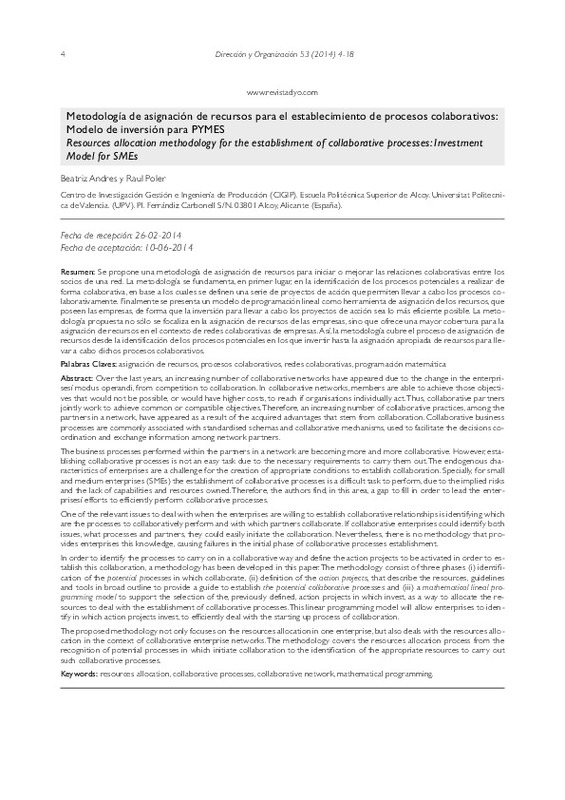|
Resumen:
|
[EN] Over the last years, an increasing number of collaborative networks have appeared due to the change in the enterprisesí modus operandi, from competition to collaboration. In collaborative networks, members are able ...[+]
[EN] Over the last years, an increasing number of collaborative networks have appeared due to the change in the enterprisesí modus operandi, from competition to collaboration. In collaborative networks, members are able to achieve those objectives that would not be possible, or would have higher costs, to reach if organisations individually act. Thus, collaborative partners jointly work to achieve common or compatible objectives. Therefore, an increasing number of collaborative practices, among the partners in a network, have appeared as a result of the acquired advantages that stem from collaboration. Collaborative business processes are commonly associated with standardised schemas and collaborative mechanisms, used to facilitate the decisions coordination and exchange information among network partners. The business processes performed within the partners in a network are becoming more and more collaborative. However, establishing collaborative processes is not an easy task due to the necessary requirements to carry them out. The endogenous characteristics of enterprises are a challenge for the creation of appropriate conditions to establish collaboration. Specially, for small and medium enterprises (SMEs) the establishment of collaborative processes is a difficult task to perform, due to the implied risks and the lack of capabilities and resources owned. Therefore, the authors find, in this area, a gap to fill in order to lead the enterprisesí efforts to efficiently perform collaborative processes. One of the relevant issues to deal with when the enterprises are willing to establish collaborative relationships is identifying which are the processes to collaboratively perform and with which partners collaborate. If collaborative enterprises could identify both issues, what processes and partners, they could easily initiate the collaboration. Nevertheless, there is no methodology that provides enterprises this knowledge, causing failures in the initial phase of collaborative processes establishment. In order to identify the processes to carry on in a collaborative way and define the action projects to be activated in order to establish this collaboration, a methodology has been developed in this paper. The methodology consist of three phases (i) identification of the
potential processes in which collaborate, (ii) definition of the action projects, that describe the resources, guidelines and tools in broad outline to provide a guide to establish the potential collaborative processes and (iii) a mathematical lineal programming model to support the selection of the, previously defined, action projects in which invest, as a way to allocate the re-
sources to deal with the establishment of collaborative processes. This linear programming model will allow enterprises to identify in which action projects invest, to efficiently deal with the starting up process of collaboration. The proposed methodology not only focuses on the resources allocation in one enterprise, but also deals with the resources allocation in the context of collaborative enterprise networks. The methodology covers the resources allocation process from the recognition of potential processes in which initiate collaboration to the identification of the appropriate resources to carry out such collaborative processes.
[-]
[ES] Se propone una metodología de asignación de recursos para iniciar o mejorar las relaciones colaborativas entre los socios de una red. La metodología se fundamenta, en primer lugar, en la identificación de los procesos ...[+]
[ES] Se propone una metodología de asignación de recursos para iniciar o mejorar las relaciones colaborativas entre los socios de una red. La metodología se fundamenta, en primer lugar, en la identificación de los procesos potenciales a realizar de forma colaborativa, en base a los cuales se definen una serie de proyectos de acción que permiten llevar a cabo los procesos colaborativamente. Finalmente se presenta un modelo de programación lineal como herramienta de asignación de los recursos, que poseen las empresas, de forma que la inversión para llevar a cabo los proyectos de acción sea lo más eficiente posible. La metodología propuesta no sólo se focaliza en la asignación de recursos de las empresas, sino que ofrece una mayor cobertura para la asignación de recursos en el contexto de redes colaborativas de empresas. Así, la metodología cubre el proceso de asignación de recursos desde la identificación de los procesos potenciales en los que invertir hasta la asignación apropiada de recursos para llevar a cabo dichos procesos colaborativos.
[-]
|







